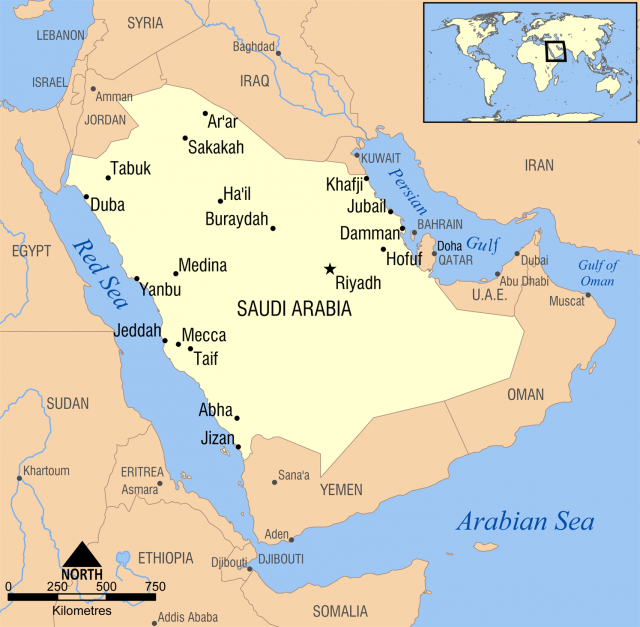Saudi Arabia
Area 756,984 square mi (1,960,582 square km)
Population 30.89 million 2014
Capital Riyadh
Highest Point 10,278 ft (3,133 m)
Lowest Point 0 m
GDP $746.2 billion 2014
Primary Natural Resources petroleum, natural gas, iron ore, gold.
LOCATED ON THE ARABIAN Peninsula in the MIDDLE EAST between the ARABIAN SEA, the RED SEA, OMAN, YEMEN, the UNITED ARAB EMIRATES, IRAQ, and KUWAIT, the country of Saudi Arabia is mostly desert. It is home to the largest sand desert in the world. The northwest of the country consists of gravelly plains, and the flat, low-lying eastern section contains the Al-Hasa oasis. The western portion of Saudi Arabia contains a mountain chain that spreads through the entire length of the country.

Throughout the mountains, forested areas contain evergreens. Scrub species and tamarinds grow in the deserts. Camels are the country's most visible animal, as well as a few hedgehogs and sand cats. Hamadryas baboons are located in Asir. These flora and fauna try to survive in an extreme climate. In the deserts from April to October, daytime temperatures rise to 113 degrees F (45 degrees C). Rain falls in the coastal areas regularly, and high humidity is common in the summer months.
In 1932, under the rule of Abd al-Aziz-ibn Saud, the Kingdom of Saudi Arabia was created. During the first half of the 1930s, Ibn Saud ruled over a kingdom that was relatively poor. Riyadh became the center of the kingdom and housed all of its administrative offices. Much of the revenue was brought in through the annual pilgrimages to Mecca, the Muslim holy site. In 1933, the Saudi Arabian government signed a concession agreement with Standard Oil of California. Sustainable exploration of oil began, and five years later, oil was discovered on the Arabian Peninsula. However, with the outbreak of World War II, the oil did not immediately become a sustainable source of revenue.
During World War II, Saudi Arabia was officially neutral. However, Ibn Saud voiced his support for Britain. As the war continued, the country depended greatly upon British and American subsidies. The United States, with concern over decreasing American oil production, turned to Saudi Arabia, and thus increased its oil explorations in the country.
Saudi Arabia struggled economically after the war. Ibn Saud died in 1953, and his son Saud became the ruler and tried to define Saudi Arabia's policies. The population of Saudi Arabia grew disenchanted with wasteful government spending, low wages, lack of public projects, and missing educational institutions. By the late 1950s into the early 1960s, Saud's brother Faisal was growing stronger in the government. Faisal became the deputy prime minister and eventually foreign minister in 1962. He alone created stronger relations with President John F. Kennedy's administration in the UNITED STATES and began a social reform program to invigorate the economy. After lack of administrative control, Saud was deposed as king and Faisal took over the reign.
Faisal immediately implemented programs that challenged development in the country. He used oil revenues to stimulate the growth in the economy and reaffirmed Islamic principles into the society. He also believed in the introduction of Western technology, and a stronger education system.
In October 1973, after SYRIA and EGYPT attacked Israel, Saudi Arabia and the Organization of Petroleum Exporting Countries (OPEC) boycotted oil shipments to the United States. This form of economic warfare displayed the power of oil and rapidly placed Saudi Arabia on the world stage. The price of a barrel of oil was raised, and the oil revenues aided the state-run programs.
However, before many of the programs had just really begun, Faisal was assassinated. Khalid was the successor to the throne but handed much of the responsibility to Crown Prince Fahd. Saudi Arabia soon embarked on a rapid development plan, which modernized infrastructure, including the transportation system and petroleum facilities. Many foreign workers were employed in the kingdom and a new class of teachers, civil servants, military officers, and businessmen emerged.
By 1990, Saudi Arabia emerged as an influential country in the Middle East. When Iraq invaded Kuwait, Saudi Arabia allowed the international alliance, including 600,000 American soldiers to gather in its country in order to protect it, and to serve as a headquarters for Operation Desert Storm. After the successful Persian Gulf War, around 5,000 American soldiers remained in the country, prompting criticism from Islamic religious leaders over Saudi cooperation with Western nations. In November 1995, a terrorist bomb outside an American military training center in Riyadh killed five Americans. In June 1996, a truck bomb exploded outside a military residence, killing 19 American servicemen. As the Taliban gained control of AFGHANISTAN, Saudi Arabia was one of three countries to formally recognize the fundamentalist government. In February 1998, Osama bin Laden, the leader of al-Qaeda and originally from Saudi Arabia, issued a statement for Muslims to rise up and kill Americans and allies.
On September 11, 2001, when al-Qaeda hijackers (15 of 19 were from Saudi Arabia) attacked the United States, the Saudi government immediately condemned the actions. Over the previous few years, Saudi Arabia has faced criticism from the United States in its role in the war on terrorism but continues to be an ally of the U.S. government. Saudi Arabia has also continued to witness its share of terrorist acts. During 2003, terrorist bombings in May and November killed many and resulted in a major crackdown on fundamentalist groups in the country. As the Middle East faces uncertain times, Saudi Arabia continues to balance interests by continuing to support the United States, while still being a center for the Islamic religion.